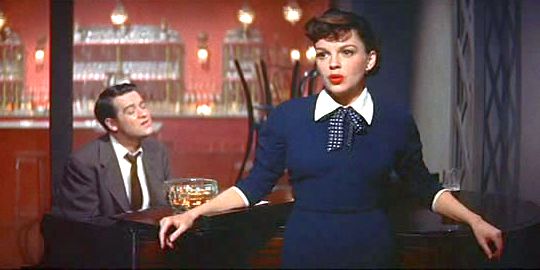
I just finished reading Norman Jewison’s autobiography, “The Terrible Business Has Been Good To Me.” It’s full of great stories about movies he directed, including “Fiddler On The Roof,” “The Hurricane,” and “Moonstruck.” He was also responsible for a trio of all-time titles — “The Cincinnati Kid,” “The Russians Are Coming, The Russians Are Coming,” and “In The Heat Of The Night” — which he made in consecutive years (1965-7).
I did not know until devouring the book that Jewison also directed Judy Garland’s 1962 CBS special, which she got because of a triumphant concert at Carnegie Hall in April, 1961. The audio from that event was remastered and cleaned up for release a few years ago as a two-CD set, which I just borrowed from our public library. It’s remarkable to listen to six decades later.
Garland was in very good voice that night and gave a performance that critics and attendees raved about for days afterwards. She sang two dozen songs, accompanied by an orchestra led by Mort Lindsey (later the band leader on Merv Griffin’s TV show). It revived her career yet again and led to not just the CBS special, but a series of hour-long primetime shows that got big ratings.
One of the highlights of the Carnegie Hall concert was Judy singing “The Man That Got Away” (music by Harold Arlen and lyrics by Ira Gershwin). Seven years earlier, she had sung it in the first remake of “A Star Is Born,” in which she starred opposite James Mason. As good as the 2018 version with Bradley Cooper and Lady Gaga was, it’s the 1954 movie that has always been a favorite of mine.
Director George Cukor shot three different versions of the song over the course of several months. They all took place in an after-hours club that’s closed for the night except for some musicians who are playing for themselves, for the fun of it. The first two versions, shot in the fall of 1953, were scrapped because, while the performances were all fine, the look was bland and the angles were wrong. They were included in a DVD re-release of the movie a few years ago — you can find them on YouTube.
Finally, in February, 1954, Cukor figured out the right costuming, lighting, and camera placement. He captured Garland in one continuous shot that shows her power, her presence, and the finesse of her performance. There’s no fancy choreography, no backup singers, nothing to take focus away from a great singer belting out a great song.
I’ve watched this scene dozens of times and it still sends chills down my spine. I consider it one of the greatest vocal performances I’ve ever seen or heard.
